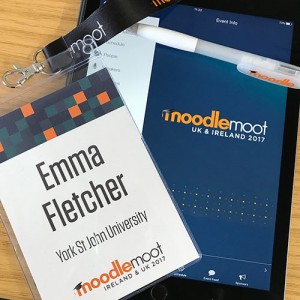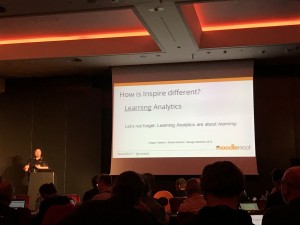 Last week I was fortunate enough to attend the 2017 UK and Ireland MoodlMoot, Moodle’s annual conference, this year held in London across three days (10-12th April, although I was there 11-12th). The MoodleMoot is hosted by Moodle HQ, the driving organisation behind the Moodle open source project, and was organised by Gavin Henrick. The two day programme was made up of keynotes; workshops run by Moodle HQ staff, Moodle partners and community members; presentations by speakers from around the country and across the globe and community panel sessions. Here are some of my thoughts and highlights from the two days.
Last week I was fortunate enough to attend the 2017 UK and Ireland MoodlMoot, Moodle’s annual conference, this year held in London across three days (10-12th April, although I was there 11-12th). The MoodleMoot is hosted by Moodle HQ, the driving organisation behind the Moodle open source project, and was organised by Gavin Henrick. The two day programme was made up of keynotes; workshops run by Moodle HQ staff, Moodle partners and community members; presentations by speakers from around the country and across the globe and community panel sessions. Here are some of my thoughts and highlights from the two days.
MoodleMoots are the place to recharge your practice: discover the state of the art in online learning, meet peers using Moodle in other institutions, and share your discoveries in an open, inclusive environment.
Martin Dougiamas, CEO and Founder, Moodle
The first day started with the keynote, delivered by Gavin (with a guest appearance from Martin Dougiamas), covering Moodle news and future roadmap. In this he went through the mission, vision and values of Moodle, the new features seen in 3.1 and 3.2 before looking ahead at Moodle 3.3 (which is scheduled for release in early May) and the future of Moodle in 3.4. Below is a storify of some of the tweets during this keynote:
For the remainder of the first morning of I chose to attend the parallel presentations on Moodle quizzes, including this one presented by Tim Hunt and Chris Nelson from the OU about what makes a good quiz. A key message from this presentation was the quizzes are not about the marks, they’re about the learning that takes place. It’s always useful to see good practice from other institutions, this is one of the benefits of attending the MoodleMoot. You can see the slides from this presentation below:
In the afternoon there were more parallel sessions to choose from, one presentation which I found interesting was Lewis Carr‘s on Excellence in the Design of Learning Content. He spoke about the importance of the content as well as the design of it saying, “Try and be original, try and build your own content. Learners appreciate quality, that includes the presentation of it”. He described the 6 key strands of learning design:
- Content and performance need alignment
- Content innovation
- Media & learning
- Interactivity
- Content optimisation
- Learner engagement
He emphasised how important it is to listen to your learners and revise the content throughout, not just at the end. You can see his slides below:
Lewis also had a poster at the event, entitled Creating Effective Feedback Loops in Moodle. Which again follows the idea that content should continually reflected upon and used to improve the course.
The first day ended with a panel discussion “Is it time to thrown away your desktop and start designing for Mobile first?” presented by Juan Leyva from Moodle HQ. Mobile learning was obviously a key driver for Moodle, their data has shown a rise in mobile access to content.
 The second day started with a panel on “Should AI and Learning Analytics replace teachers”, was an interesting and thought provoking topic. Following this I attended the presentation “Learning Analytics through Machine Learning – Project Inspire” presented by Gavin Henrick.Moodle has Project Inspire which is essentially their Analytics Plan. The project aims to identify and validate, indicators of student, teacher and institutional engagement in educational activities. Information from the project will be used to develop learning analytics software features in Moodle, which will have these functions:
The second day started with a panel on “Should AI and Learning Analytics replace teachers”, was an interesting and thought provoking topic. Following this I attended the presentation “Learning Analytics through Machine Learning – Project Inspire” presented by Gavin Henrick.Moodle has Project Inspire which is essentially their Analytics Plan. The project aims to identify and validate, indicators of student, teacher and institutional engagement in educational activities. Information from the project will be used to develop learning analytics software features in Moodle, which will have these functions:
- Description of learning engagement and progress,
- Diagnosis of learning engagement and progress,
- Prediction of learning progress, and
- Prescription (recommendations) for improvement of learning progress.
The learning analytic was another theme of the conference (along with both design and mobile learning) and ran through my choices the second day, with “Measuring the impact of learning in Moodle” presented by Peter Dobinson from LEO learning. He spoke about the value of measuring the impact of learning (e.g. you can prove what works, can create more effective learning programmes) which could be done by using learning analytics. A key message from this presentation was; if you are measuring things and not using them to improve what you do then why are you measuring them? You can see the slides from this presentation below:
The conference was a great chance to see what other institutions are doing with Moodle as well as see some of the intended developments for Moodle. I enjoyed my two days at the event, thanks to Moodle HQ and Gavin for putting together such an interesting programme of events (and choosing such a good venue, the cakes alone were almost worth the trip). This blog post is only a snapshot of the event covers just a few of the presentations and workshops I attended, there was far more than I could fit into it! If you want to find out more the #MootIEUK17 Twitter hashtag is a great source, lots of attendees and presenters sharing thoughts and slides, and Moodle plans to share some videos of some of the presentations from the Moot on their YouTube channel.
Emma

0 responses on "MoodleMoot 2017 #MootIEUK17"